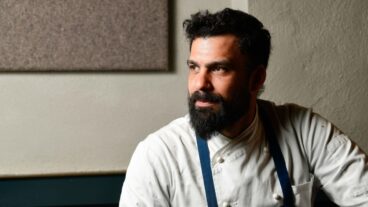Contemporary jewelry artist Esther Knobel, recipient of this year’s Andrea M. Bronfman Prize for outstanding Israeli decorative artists, creates timeless pieces that can be as ephemeral as flower petals.
For artist and jeweler Esther Knobel, winning this year’s Andrea M. Bronfman Prize for the Arts (the Andy), for her series The Mind in the Hand which premiered in Massachusetts in June, couldn’t have come at a better time.
“The application process meant that I was in the midst of a retrospective look at 30 years of work,” she tells ISRAEL21c. “Winning the prize, having the opportunity for an exhibition, getting the chance to interpret my work through the medium of a catalogue, having a museum backing you – it’s like heaven.”
Knobel, who is in her early 60s, has always prided herself on being a little different. Born in Poland in 1949, she immigrated with her family to Israel at the age of one, moving to bucolic Ramat HaSharon where the flower petals, leaves and pine needles that would later figure in her work were all part of her childhood experience.
She graduated from Bezalel Academy of Art and Design in Jerusalem in 1974, moved to London and received her Masters in Jewelry Design from the Royal College of Art in 1979. It was the height of the punk era, and Knobel was part of the scene.
“My work was always a bit outside the mainstream,” she admits. “The 60s and 70s were an interesting time in European contemporary jewelry. I was very interested in jewelry that borders on art, and the avant garde there influenced my work.”
She accepted the Royal College’s requirement for technical excellence but railed against its conservative approach. Her final project, Pine Needle Necklace (1977), a chain of anodized aluminum loops, “was a rebellion against the ethical, material, and technical stodginess that prevailed in the discourse of jewelry design in those years.
The safety pin, hallmark of punk, is another recurring motif for Knobel. “…in London at the time, the safety pin was identified with a harsh and aggressive fashion style, but to me it pointed in the exact opposite direction: an object borrowed from nature, or a tribute to the early childhood years, like the pine needle enclosed within its sheath,” she says.
Knobel returned to Jerusalem to teach at Bezalel and later on, at the Shenkar College of Textile Technology and Fashion. She left teaching over 10 years ago but continues to lecture at art institutions around the world, from Cologne to Seattle to Tokyo. “Teaching, imparting knowledge, is very important in every creative field. It’s important [in the arts] that the teacher be a working artist and that working artists teach.”
The Mind in the Hand series, which was on show at the Sienna Gallery, is Knobel’s attempt to clarify the Hebrew term milekhet mahshevet (work of craftsmanship) in a series of silver brooches etched with line drawings of hands at work.
It won the attention of the judges for the Andy, which was established by philanthropist Charles Bronfman in 2005 to honor his late wife’s passion for the arts. “The Andy Prize reflects innovation and excellence, and every stage of Knobel’s work clearly represents these ideals,” stated Charles Bronfman.
Knobel has won other awards during her career including the Bezalel Prize of Excellence (1974) and the Françoise van den Bosch Prize (1994). Her jewelry can be found in the collections of numerous international museums, including the Stedelijk Museum Amsterdam, the Museum für Angewandte Kunst, Vienna, the Craft Board of the Australia Council, Sydney, and the Israel Museum, Jerusalem.
She recently participated in Women’s Tales, a traveling group exhibit of four leading Israeli contemporary jewelers produced by the Racine Museum of Art and the Israel Museum. The show is due back in Israel next year.
As part of the NIS 50,000 Andy prize, Knobel’s has a show, entitled Long Distance Runner, on display at the Tel Aviv Museum of Art, and two works will be purchased for the Tel Aviv Museum and the Israel Museum in Jerusalem.
Knobel’s main focus has always remained on making quality contemporary jewelry that transcends season and fashion.
“There’s a reason why I called the show Long Distance Runner,” says Knobel. “I thought the name expressed a sort of consistency over time that’s the opposite of fashion.”
Timelessness doesn’t mean that her pieces are built to last, she adds. In fact, one of Knobel’s most famous and oft-copied pieces is a brooch made of a real flower atop a silver stem. “Durability doesn’t interest me,” she admits.
What does interest her is the interplay between jewelry and its wearer. “There’s a trend in the US right now of calling jewelry ‘small sculpture’ – sort of to upgrade its status – but I don’t buy it. I don’t view my works as separate from the body, they always relate to the human proportion, the world or people. The context is human. Plus, the body is a good place to display them.”













